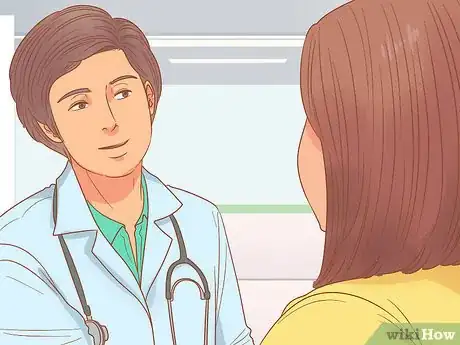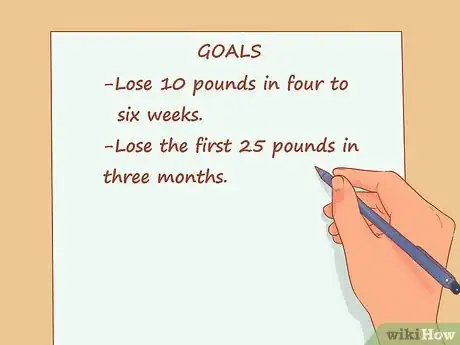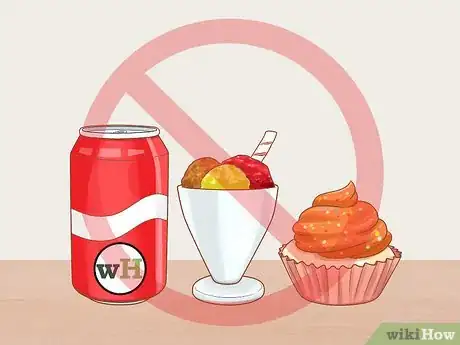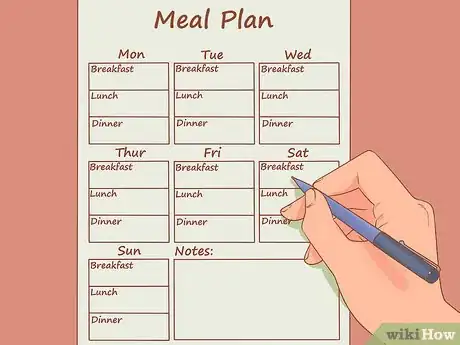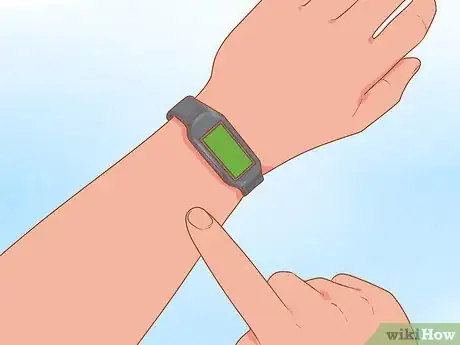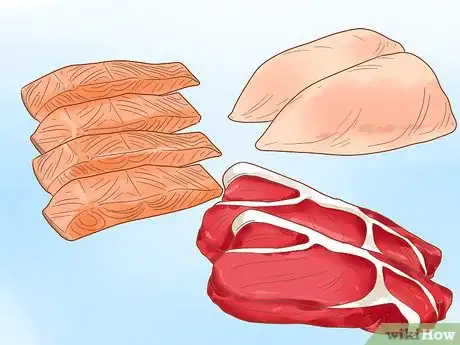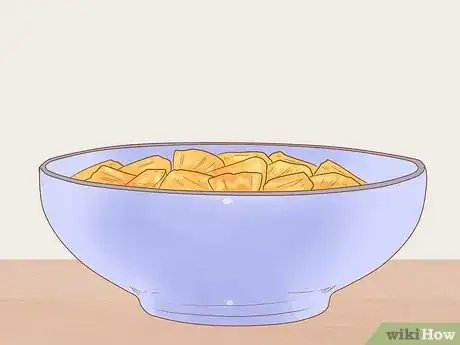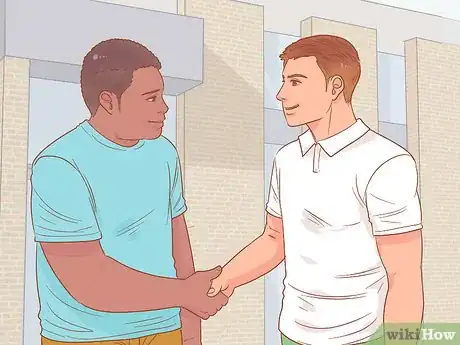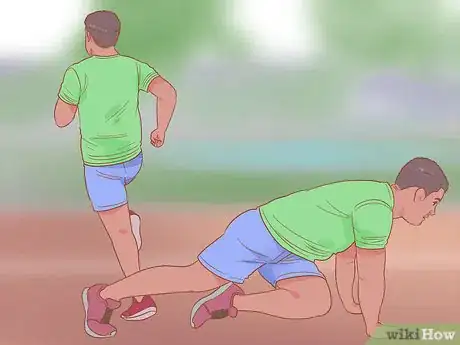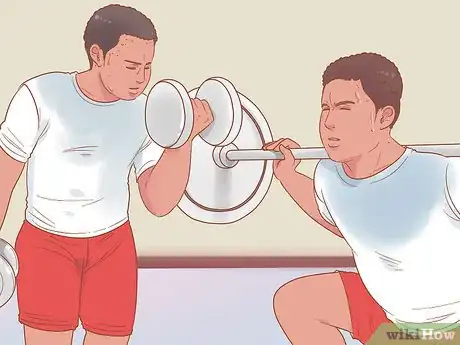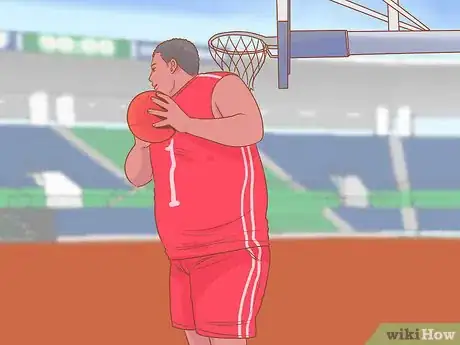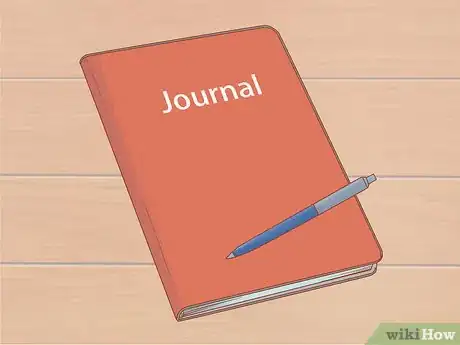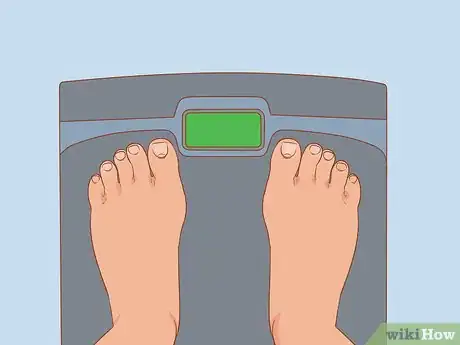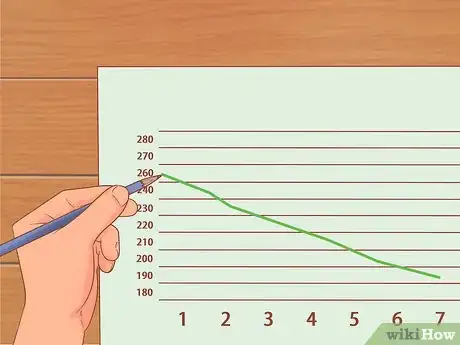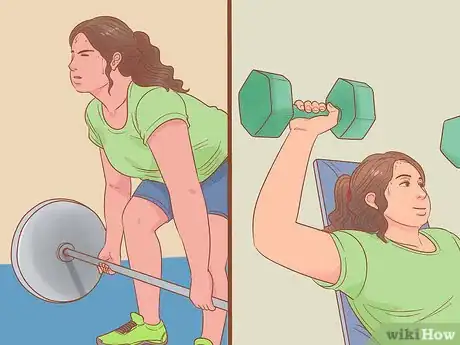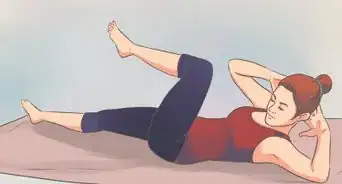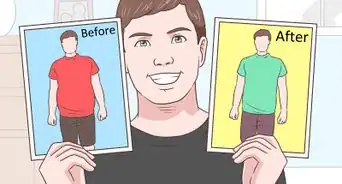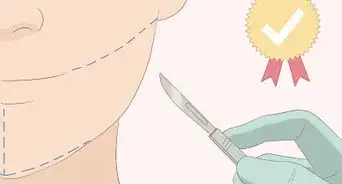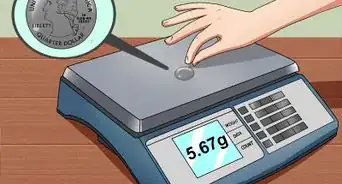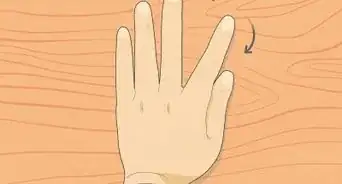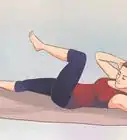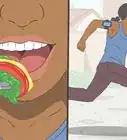This article was co-authored by Claudia Carberry, RD, MS. Claudia Carberry is a Registered Dietitian specializing in kidney transplants and counseling patients for weight loss at the University of Arkansas for Medical Sciences. She is a member of the Arkansas Academy of Nutrition and Dietetics. Claudia received her MS in Nutrition from the University of Tennessee Knoxville in 2010.
There are 13 references cited in this article, which can be found at the bottom of the page.
wikiHow marks an article as reader-approved once it receives enough positive feedback. In this case, 89% of readers who voted found the article helpful, earning it our reader-approved status.
This article has been viewed 223,448 times.
If you need to lose 100 pounds, it usually signifies that your weight and BMI are at level high enough that you fall into the obese or morbidly obese category. When you have a significant amount of excess weight, you're at higher risk for a variety of health conditions including diabetes, high blood pressure, or heart disease. Losing weight can help reduce the risk of these diseases or help reduce the effects of these diseases in addition to making you feel better overall. But attempting to lose large amounts of weight can be a long and difficult process. With adequate preparation and appropriate diet and exercise you can lose enough weight to help you reach your target weight and other health goals.
Steps
Planning for Large Amounts of Weight Loss
-
1Talk to your doctor or registered dietitian. It's essential to talk to your doctor to make sure your weight loss program is safe and appropriate for you.
- In addition to speaking with your doctor, making an appointment to visit a registered dietitian may be a good idea. These nutrition and weight loss experts will be able to guide and teach you about safe and healthy weight loss.
- If you have 100 pounds of excess weight to lose, you may also be suffering from chronic diseases that are associated with being overweight or obese. Therefore, it's even more important to speak with your doctor about what type of weight loss is appropriate for you.
-
2Set goals. Losing 100 pounds is a big goal and will require you to commit to a weight loss program for an extended period of time. Setting realistic goals is important, especially when you want to lose larger amounts of weight.[1]
- Losing weight at a faster rate may be unhealthy and unsafe. In addition, it's generally not sustainable long-term and may put you at risk for gaining the weight back.[2]
- Setting a large, long-term goal is great, but it may be helpful to set smaller goals along the way to help motivate you on your weight loss journey. For example: lose 10 pounds in four to six weeks or lose the first 25 pounds in three months.[3]
Advertisement -
3Get rid of unhealthy foods in your home. This is perhaps the most effective change you can make immediately that will help get you started on the road to losing weight. The more tempting food you have lying the house, the more likely it is that you will give in and eat those unhealthy items. Creating a healthy environment at home can help support your weight loss.
- Toss out any sweets (like cookies, cupcakes or ice cream), chips, crackers and sugary beverages (like soda or fruit juice cocktail).
- You can also donate unopened items to a local food bank instead of throwing items in the garbage.
- Think, "out of sight, out of mind." Having these foods out of your house will help you stick to your plan and eat healthier.
-
4Write a meal plan. Getting started on a weight loss plan to lose 100 pounds will require you to re-think your meals. Spending a few hours reworking your weekly meal plan can help give you the framework for a healthy diet.
- Consult with a registered dietitian to ensure that your meal plan is also safe in regards to your medical history.
- Start with one week of meals. Include all breakfasts, lunches, dinners, snacks and sugar-free beverages.
- If you're following a particular calorie range, be sure to add in the calories for each meal and snack to make sure you're staying within your predetermined range.
- After a few weeks, you may be able to be less detailed with your meal plan — especially if you get into the groove of healthy, easy meals that you enjoy.
- If you notice yourself getting bored with your meals, revisit your meal plan and change it up. Don't fall off track out of boredom. Find new, healthy recipes to keep you on track.
Eating to Lose Weight
-
1Monitor calories. Losing weight will require you to cut back on calories to help induce weight loss. Following a moderate calorie diet over time will help you reach your weight loss goals.
- In general, cutting out about 500 calories daily will yield a weight loss of about 1–2 pounds a week. This is considered safe and healthy weight loss.[4]
- Cutting out larger amounts of calories or eating less than 1,200 calories daily is not considered safe, healthy, or appropriate. You're putting yourself at risk for nutrient deficiencies as it is hard to consume all the nutrients you need on a very low calorie diet. In addition, these types of diets are generally not sustainable long-term.[5]
- If you're interested in following a particular calorie limit, you can plug in your height, weight, and activity level into an online calculator to help determine what's an appropriate calorie level to follow when attempting to lose weight.
- You may also talk to your registered dietitian about what calorie level is appropriate for you based on your weight loss goals.
-
2Eat lean protein at every meal. Eating foods that are high in lean protein is essential to weight loss. Protein helps keep you feeling satisfied and helps fuel your weight loss.[6]
- Eat a source of lean protein at every meal and snack. This will help you meet the minimum requirements each day.
- In general, women should consume 46 g of protein daily and men should consume 56 g of protein daily.
- Foods that are high in lean protein include: poultry, lean beef, eggs, pork, seafood, tofu, legumes, and low-fat dairy products.
- Minimize higher fat protein foods as these contain more calories and could slow weight loss. Items like fatty cuts of beef, sausage, bacon, full-fat dairy, or poultry with skin should be eaten only occasionally.
-
3Make half your meals a fruit or vegetable. These foods will help support your weight loss as they are very low calorie and can help provide bulk to your meals and keep you feeling satisfied longer.
- Include a variety of fruits each day or week. Ideally eat about one to two servings of fruit each day. A serving counts as 1/2 cup cut fruit, one small piece of fruit, or 1/4 cup of dried fruit.[7]
- Eat a variety of vegetables each day or week. Aim for at least three to five servings of vegetables each day. A serving counts as 1 cup or 2 cups of leafy greens.[8]
- Starchy vegetables like carrots, peas, or potatoes are appropriate to include on a weight loss plan. They do contain slightly more calories, but are acceptable to eat when you're trying to lose weight.
-
4Choose 100% whole grains. When you're choosing to eat grains, go for 100% whole grains as often as you can. Whole grains are high in fiber, vitamins and other essential nutrients.[9]
- Whole grains to include are: quinoa, oats, 100% whole wheat bread or pasta and brown rice.
- One serving of whole grains is 1 oz or 1/2 cup. Include one to two servings daily.[10]
- Monitor the amounts of whole grains you consume while trying to lose weight. Although a part of a healthy diet, whole grains contain more calories and less nutrients compared to lean protein, fruits, and vegetables.
-
5Snack healthy. When you're cutting down on calories and increasing exercise, you may find yourself more hungry throughout the day. Snacking may help manage your hunger while continuing to support your weight loss.[11]
- Snacks should be included when appropriate. For example, if there's more than five hours between meals or as fuel before or after a workout.
- Snacks should also be monitored closely. If you're not hungry or it's close to a meal time, pass on your snack. Eating extra calories when not necessary may slow or hinder your weight loss. Be smart when you're snacking.
- Snacks should be around 100-200 calories when you're trying to lose weight.[12] Healthy snacks that can support your weight loss include: an individual greek yogurt, a hard boiled egg, carrots and hummus, or 1/2 cup of edamame.
- Make healthy swaps for your favorite snacks. If you find yourself missing your old comfort foods, try swapping out healthier foods for those higher calorie snack foods. For example, instead of cookies after dinner, have a 1/2 cup of pineapple to cut your sweet craving.
-
6Indulge in moderation. Although dieting requires you to follow a program for an extended period of time, it's also important to indulge occasionally. Completing avoid certain foods long-term may trigger a binge.[13]
- Schedule in the occasional indulgence into your meal plan. It can be anything, for example: going out to dinner or eating a small sweet. Scheduling this into your meal plan can help you see how you can compensate. You may consider spending 10 more minutes on the treadmill or having lighter meals throughout the day.
- Be honest about your indulgences. They should be occasional — this will be different for everyone, but these things shouldn't be popping up daily.
-
7Drink enough water. Adequate fluids helps you stay hydrated which will support your weight loss. When you're dehydrated you may feel hungry and tired which could trigger you to eat. Extra calories may result in slow weight loss or a weight stall.[14]
- Aim for at least 64 oz or about 2 L of clear, sugar-free fluids each day. This is a good rule of thumb to remember, but you may need more fluids.[15]
- Sugar-free fluids to sip on include: water, flavored waters, tea and coffee, or no-calorie sports drinks.
Exercising to Lose Weight
-
1Meet with a personal trainer. Try setting up a consultation with a personal trainer to help get you started with an exercise program. These fitness professionals will help you find a workout that can help you lose weight and keep your weight loss off permanently.
- Tell your trainer about your weight loss goal and diet and they'll be able to work with you to meet those goals. In addition, ask them about exercises that may be more comfortable for you. If your excess weight is causing joint pain, they may be able to teach or show you exercises that lessen your pain.
- Many times you can get a free or promotional consultation with a trainer when you sign up for a gym membership.
- Also, try using a trainer just a few times or until you get the hang of the workout. You don't necessarily need a personal trainer long-term if you don't want one.
-
2Add in cardio exercise. Aerobic training is a great exercise to burn calories. This will not only help support your weight loss, but you'll also notice a variety of other benefits like increased energy and improved moved.[16]
- It's recommended to incorporate 150 minutes of moderate intensity aerobic activity each week. However, the more exercise you do, the more calories you can burn, which may help increase your weight loss.[17]
- If you have a significant amount of excess weight, start slowly with exercise. If you cannot do 150 minutes per week, that's OK. Start with just 10 minutes per day.
- Include cardio exercises like: fast walking, biking, using the elliptical or swimming/water aerobics.
-
3Incorporate strength training. Strength training is another form of exercise that will help support your weight loss. Include 1–2 days of strength training each week.[18]
- Strength training helps build lean muscle mass which, over time, burns more calories compared to fat mass in the body. Increasing your muscle mass will help you burn more calories all day long.[19]
- Strength training can also help tone and contour your body to help you achieve a more lean and toned look.
- Strength training activities include: weight lifting, yoga, or resistance bands/tubes.
-
4Find an exercise that you enjoy. It's important that you find a type of activity that you genuinely enjoy; that way you will be more likely to stick with it and do it on a regular basis.
- Try a variety of exercises that you think you may enjoy. This will give you a good idea of what exercises you'll most likely keep doing long-term.
- Think outside the box. Hiking, dance classes, kayaking, or team sports are all fun and exciting forms of exercise.
- Switch up your routine. After a while, an exercise routine may get boring or old. Switching up your routine every once in a while can help keep it fresh and fun.
- Exercise with a friend for a social and motivating workout. You're more likely to keep going if you're working out with a friend.
Staying Motivated
-
1Keep a journal. Studies have shown that journaling while trying to lose weight makes it more likely that you'll reach your goal and keep your weight off long-term.
- Journaling provides an emotional outlet allowing you to get out frustrations or disappointments or set backs. It can also be a way to motivate yourself. Writing down positive mantras or tracking your successes can keep you on track.
- Purchase a journal, download a journaling app, or find an online journaling site to check in with on a regular basis. You don't need to journal each day if you don't want to — even a few times a week counts.
- Jot down notes about your meals, progress, measurements and how you're feeling throughout your diet program.
-
2Go to a support group. Having a support group is essential to weight loss — especially when you're trying to large amounts of weight. It will take time to reach your goal of losing 100 pounds and it may be a long journey, and having a person or group of people to encourage and motivate you will be helpful.[20]
- Find friends or family members and tell them about your goal. Ask them to help you stay accountable and encourage you until you reach your goal.
- Also try finding support groups in person or online. Having people to talk to who are also struggling with weight or attempting to lose large amounts of weight will also help encourage and motivate you.[21]
-
3Track your progress. The more weight you lose, the more motivated you will feel to keep going. But the only way to know whether you are making progress is to take regular measurements.
- Weigh yourself once or twice a week. Be sure to do this at the same time each week. Mornings before you have eaten anything are best.
- Remember that clothes and shoes weigh something, too. For the most accurate results, weigh yourself naked or in just your underwear. Try to always be undressed or wearing the same thing when you weigh yourself for consistency.
- Take measurements. Use a tape measure to measure the circumference of your waist, thighs, arms, and neck. As you lose weight and are working out regularly, you'll see your body shape changes as well.
Overcoming Plateaus
-
1Document your weight stalls. The occasional weight plateau is normal and should be expected when you're trying to lose large amounts of weight. As you shed more and more weight and you continue to exercise, your body readjusts. This sometimes results in a few days or weeks where your weight doesn't budge on the scale.[22]
- Track your weight stalls. This is important because if you don't resume losing weight, you'll need to reevaluate your diet, exercise program and other lifestyle behaviors to make sure they're still conducive to weight loss.
- If you notice a weight stall and you're still on track with diet and exercise, don't stress. Trust yourself and continue with your plan. Remember, weight plateaus are normal and are to be expected. Do not give up or try new fad diets to make yourself lose weight. Stick to your plan.
-
2Review your food journal. Keeping a food journal doesn't just help you stay on track and support your weight loss, it's also a good tool to help reevaluate your progress or overcome a weight stall.
- Keep an eye out for extra snacks or indulgences. Even though you might not be doing this everyday, even a few times a week of an extra snack or treat could slow your weight loss or cause a plateau.
- Watch your recorded portions. Portion sizes that slowly get a little too big — maybe from guessing — can also cause your weight to plateau.
- Also make sure you're eating enough. Skimping too much on calories or portions may also be slowing your weight loss. A diet that's too low in calories and nutrients is not a good support to weight loss and may be displayed as a stall.[23]
-
3Change your routine. If a weight plateau is driving you nuts or making you nervous, try switching up your routine. Try adding in more or different types of exercise to help jumpstart your weight loss again.
- Try different cardio programs like HIIT or circuit training which burn a lot of calories. You can also increase or start strength training to help increase your baseline metabolism.
Expert Q&A
-
QuestionHow much does it cost to have weight loss surgery?
 Claudia Carberry, RD, MSClaudia Carberry is a Registered Dietitian specializing in kidney transplants and counseling patients for weight loss at the University of Arkansas for Medical Sciences. She is a member of the Arkansas Academy of Nutrition and Dietetics. Claudia received her MS in Nutrition from the University of Tennessee Knoxville in 2010.
Claudia Carberry, RD, MSClaudia Carberry is a Registered Dietitian specializing in kidney transplants and counseling patients for weight loss at the University of Arkansas for Medical Sciences. She is a member of the Arkansas Academy of Nutrition and Dietetics. Claudia received her MS in Nutrition from the University of Tennessee Knoxville in 2010.
Master's Degree, Nutrition, University of Tennessee Knoxville Master's Degree, Nutrition, University of Tennessee KnoxvilleExpert AnswerSurgery costs vary by procedure, facility, and insurance coverage. Talk to your doctor about getting a referral and plan to see a registered dietitian prior to surgery.
Master's Degree, Nutrition, University of Tennessee KnoxvilleExpert AnswerSurgery costs vary by procedure, facility, and insurance coverage. Talk to your doctor about getting a referral and plan to see a registered dietitian prior to surgery. -
QuestionWhich weight loss medications may be used to treat obesity?
 Claudia Carberry, RD, MSClaudia Carberry is a Registered Dietitian specializing in kidney transplants and counseling patients for weight loss at the University of Arkansas for Medical Sciences. She is a member of the Arkansas Academy of Nutrition and Dietetics. Claudia received her MS in Nutrition from the University of Tennessee Knoxville in 2010.
Claudia Carberry, RD, MSClaudia Carberry is a Registered Dietitian specializing in kidney transplants and counseling patients for weight loss at the University of Arkansas for Medical Sciences. She is a member of the Arkansas Academy of Nutrition and Dietetics. Claudia received her MS in Nutrition from the University of Tennessee Knoxville in 2010.
Master's Degree, Nutrition, University of Tennessee Knoxville Master's Degree, Nutrition, University of Tennessee KnoxvilleExpert AnswerMedications are constantly changing. Talk to your doctor to find out if there is a safe medication out there for you. Either way, diet and exercise will still have to be a part of your life.
Master's Degree, Nutrition, University of Tennessee KnoxvilleExpert AnswerMedications are constantly changing. Talk to your doctor to find out if there is a safe medication out there for you. Either way, diet and exercise will still have to be a part of your life. -
QuestionDo you lose weight faster if you are overweight?
 Claudia Carberry, RD, MSClaudia Carberry is a Registered Dietitian specializing in kidney transplants and counseling patients for weight loss at the University of Arkansas for Medical Sciences. She is a member of the Arkansas Academy of Nutrition and Dietetics. Claudia received her MS in Nutrition from the University of Tennessee Knoxville in 2010.
Claudia Carberry, RD, MSClaudia Carberry is a Registered Dietitian specializing in kidney transplants and counseling patients for weight loss at the University of Arkansas for Medical Sciences. She is a member of the Arkansas Academy of Nutrition and Dietetics. Claudia received her MS in Nutrition from the University of Tennessee Knoxville in 2010.
Master's Degree, Nutrition, University of Tennessee Knoxville Master's Degree, Nutrition, University of Tennessee KnoxvilleExpert AnswerIf you are not overweight, you do not need to lose weight. Burning calories through exercise and limiting calories in your diet will help you lose weight.
Master's Degree, Nutrition, University of Tennessee KnoxvilleExpert AnswerIf you are not overweight, you do not need to lose weight. Burning calories through exercise and limiting calories in your diet will help you lose weight.
References
- ↑ http://www.mayoclinic.org/healthy-lifestyle/weight-loss/in-depth/weight-loss/art-20048224
- ↑ http://www.mayoclinic.org/healthy-lifestyle/weight-loss/basics/weightloss-basics/hlv-20049483
- ↑ http://www.mayoclinic.org/healthy-lifestyle/weight-loss/in-depth/weight-loss/art-20048224
- ↑ http://www.mayoclinic.org/healthy-lifestyle/weight-loss/basics/weightloss-basics/hlv-20049483
- ↑ http://www.mayoclinic.org/healthy-lifestyle/weight-loss/basics/weightloss-basics/hlv-20049483
- ↑ http://www.womenshealthmag.com/weight-loss/protein-weight-loss
- ↑ http://www.choosemyplate.gov/fruit
- ↑ http://www.choosemyplate.gov/vegetables
- ↑ http://wholegrainscouncil.org/whole-grains-101/what-are-the-health-benefits
- ↑ http://www.choosemyplate.gov/grains
- ↑ http://www.mayoclinic.org/healthy-lifestyle/weight-loss/in-depth/healthy-diet/art-20046267
- ↑ http://www.mayoclinic.org/healthy-lifestyle/weight-loss/in-depth/healthy-diet/art-20046267
- ↑ http://www.prevention.com/weight-loss/weight-loss-tips/how-prevent-binge-eating
- ↑ http://www.mayoclinic.org/healthy-lifestyle/nutrition-and-healthy-eating/in-depth/water/art-20044256
- ↑ http://www.mayoclinic.org/healthy-lifestyle/nutrition-and-healthy-eating/in-depth/water/art-20044256
- ↑ http://health.gov/paguidelines/guidelines/adults.aspx
- ↑ http://health.gov/paguidelines/guidelines/adults.aspx
- ↑ http://health.gov/paguidelines/guidelines/adults.aspx
- ↑ http://health.gov/paguidelines/guidelines/adults.aspx
- ↑ http://www.apa.org/topics/obesity/support.aspx
- ↑ http://www.apa.org/topics/obesity/support.aspx
- ↑ http://www.mayoclinic.org/healthy-lifestyle/weight-loss/in-depth/weight-loss-plateau/art-20044615
- ↑ http://www.mayoclinic.org/healthy-lifestyle/weight-loss/in-depth/weight-loss-plateau/art-20044615
About This Article
If you need to lose 100 pounds, start by speaking with your doctor or a registered dietitian to decide on a weight loss plan that's appropriate for you. Next, get rid of unhealthy foods in your home like sweets, chips, and soda to create a healthy environment that supports your weight loss goals. Then, create a meal that includes lots of fruits and vegetables, lean protein, fiber, and whole grains. Additionally, consider setting up a consultation with a personal trainer to help you find an exercise program that’s right for you. For more advice from our Dietary reviewer, like how to stay motivated, read on!
